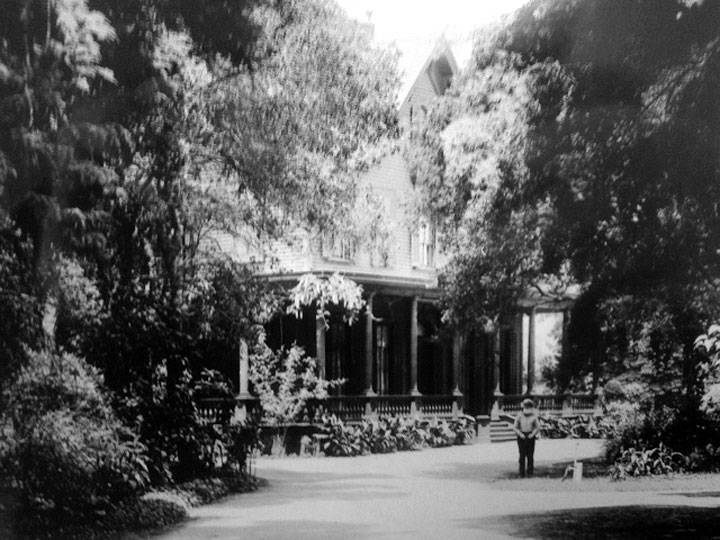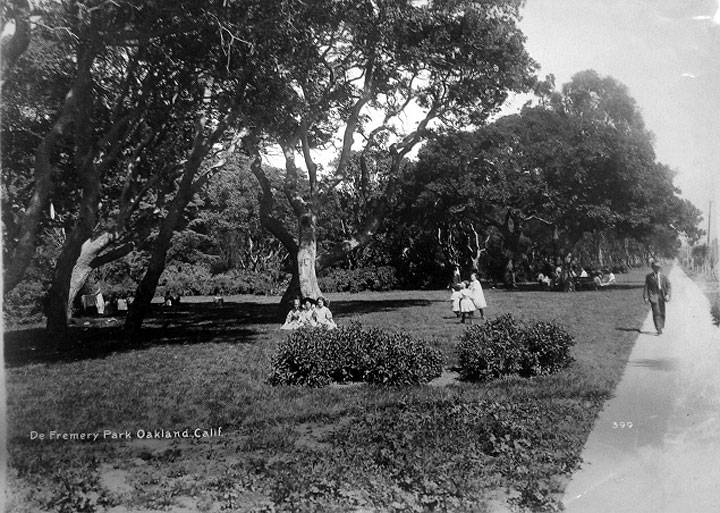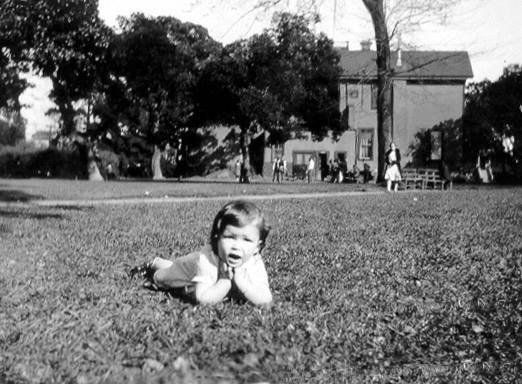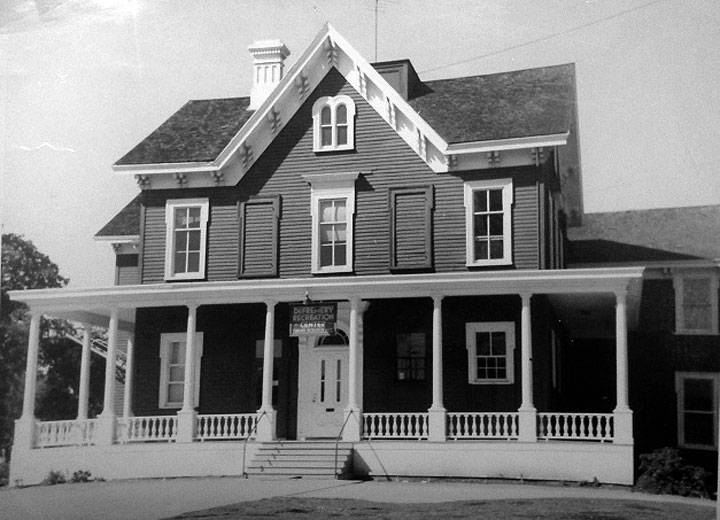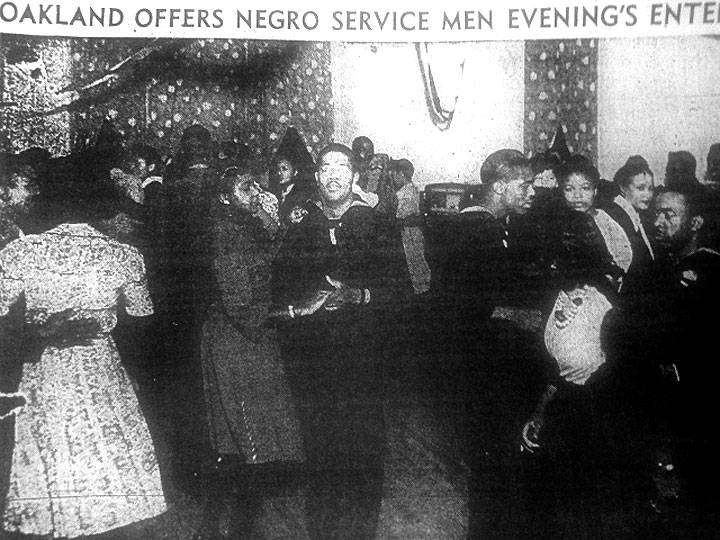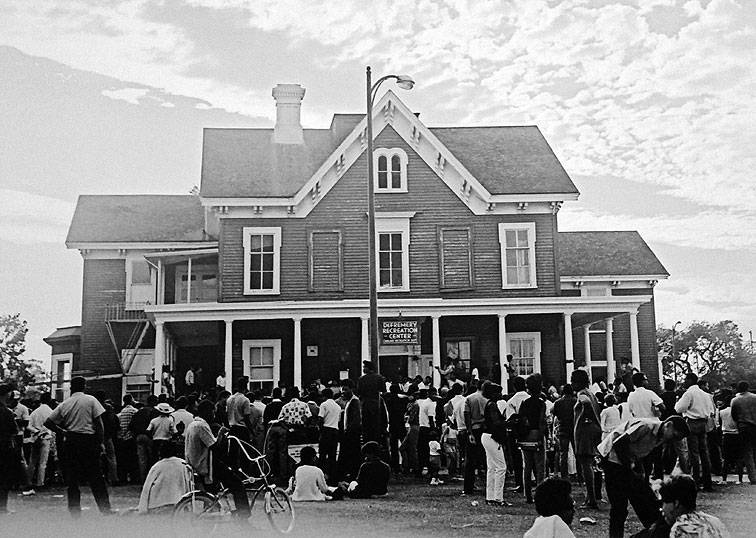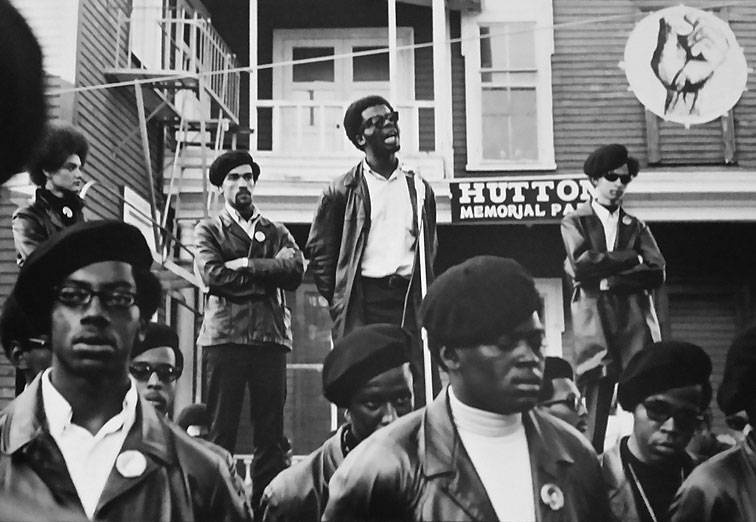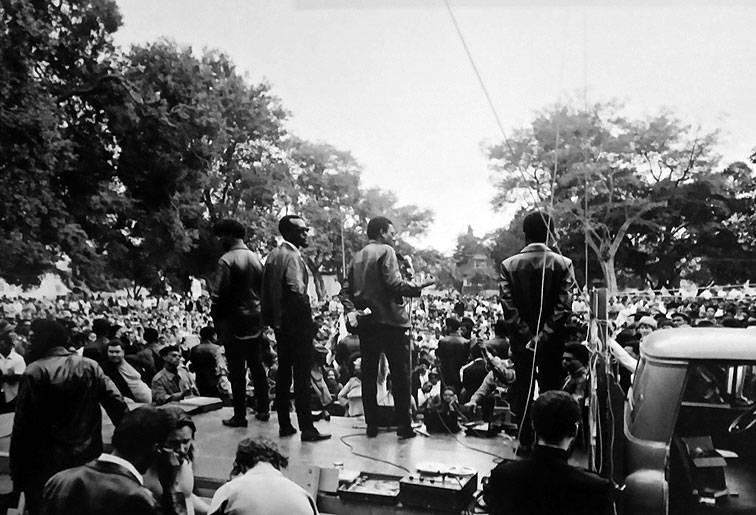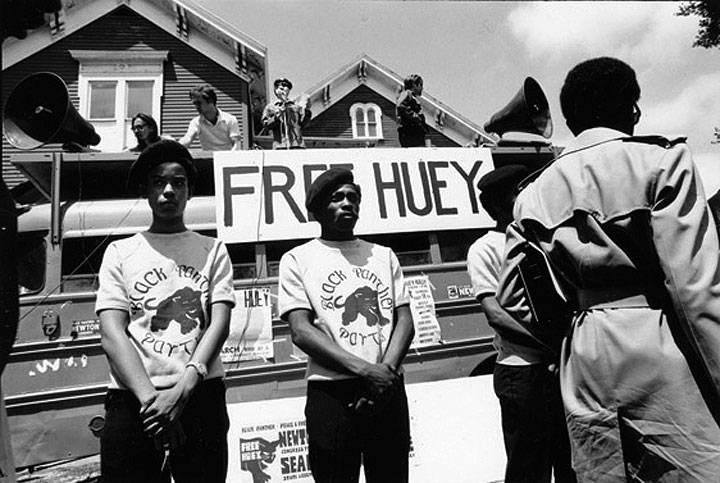De Fremery Park and Recreation Center West Oakland
Historical Essay
by Chance Grable, 2015
The De Fremery Mansion in the 1860s.
Photo: Oakland Public Library, Oakland History Room
| In the 1860’s, a giant Victorian mansion was built in the oak groves of western Oakland by James de Fremery. De Fremery, a successful San Francisco banker, sought an escape for his family from the gritty urban center that San Francisco had become. Nearly 150 years later, this mansion, still largely intact, is the de Fremery Recreation Center, the centerpiece of West Oakland’s de Fremery Park.(1) A social history of the building's evolution, from private estate to public recreation center, affords us an illustration of the changing dynamics of the surrounding area of West Oakland. From wealthy merchants to Black Panthers, there has been a broad range of forces that influenced the use of this space. As new populations, ideas and identities flowed into West Oakland, they molded the de Fremery estate to accommodate their needs and aspirations. Therefore the history of de Fremery reveals the external and internal forces that have shaped how space has been used in West Oakland. |
As San Francisco became more urban, industrial and crowded during the second half of the 19th century, some San Francisco elites migrated to Oakland to escape. The de Fremery family was one of several wealthy families who built giant Victorian mansions on large estates in the heavily wooded area of western Oakland, which was easily accessible to San Francisco by ferry. The de Fremery estate, known as the Grove because “it was covered with a dense growth of primeval Oaks,”(2) was designed to meet the desires of the de Fremery family. This place would serve as a refuge from the big city where they could relax, socialize with each other and other friends and engage in outdoor recreational activities such as hunting.(3) However this sanctuary could not be protected from the encroaching forces of industrialization and the urbanization forever.
The Progressive Playground
Photo: Oakland Public Library, Oakland History Room
In 1869 it was determined that the transcontinental railroad would end in western Oakland, ensuring a rapid industrial growth in the following decades. As new jobs were required to operate the railroads and associated industries, working class people, mainly immigrant whites, flowed into western Oakland. To meet the needs of this new flux of people, the area urbanized. This trend was not unique to Oakland. Across the nation industrialization had led to rapid urbanization and the creation of often crowded and under-serviced neighborhoods that were seen as breeding grounds for vice, disease and immorality by many middle and upper class Americans.
The de Fremery family had responded to these negative connotations of urbanization decades earlier by fleeing San Francisco, but by the late part of the 19th century, the de Fremerys were part of a growing progressive movement that sought to confront the ills of urbanization more directly. James de Fremery used his resources to alleviate impacts on senior women and children. Writing in 1966, reporter Nancy Turpin stated that he was “involved in philanthropy. One early charitable venture was a home for elderly women,” opened in 1882 followed by the 1889 opening of de Fremery Cottage, a child care nursery.(4) These establishments became part of a broader “charitable landscape” of settlement homes, kindergartens, and orphanages that “played a key role in addressing the social ills brought about by industrialization and urbanization” in Oakland.(5) By the early 20th century, the de Fremery mansion itself would be dedicated to this cause.
The functionality of the de Fremery mansion as a getaway for the de Fremery family was fading as urbanization encroached on the estate. James de Fremery junior conceded in 1904 that the estate “was all that was left of Old Oakland.”(6) The new Oakland was urban, industrial and filled with residents who were not getting their needs met in the over-crowded urban space. Among these residents were children that, according the City of Oakland's Parks and Playground Commission at the time, had their “divine right to play… restricted until the only playgrounds were the streets.”(7) One manifestation of the progressive era in Oakland was the Playground Movement, which was “designed to meet the physical and social needs of the upgrowing generation” by establishing playgrounds in urban areas.(8) The de Fremery estate would be converted into Oakland’s first municipal playground in 1907 when the city bought it from James de Fremery Jr.(9) The local government's decision to purchase the de Fremery land and convert it into a space to serve working class people illustrates how the progressive movement migrated into government from privately run and funded charitable efforts. This migration is apparent throughout the history of de Fremery.
Betty Besoain enjoys the grass at De Fremery Park, ca. 1931.
Photo: Collection of B. Corff
The WPA-era Clubhouse.
Photo: Oakland Public Library, Oakland History Room
The de Fremery Clubhouse and the Works Progress Administration
Twenty years after the de Fremery mansion was converted into a recreational area, industrial capitalism was again failing to meet the needs of working class residents. The Great Depression of the 1930s hit Oakland and many of the industrial jobs held by working class people disappeared. The de Fremery house would be transformed again to meet the needs of residents. The federal government, which was very much alive with the progressive spirit, was the driving force enabling this change. The federally funded Works Progress Administration (WPA) and Oakland Recreational Department jointly established an Oakland Recreational Leadership Project in the “Defremery Park Clubhouse”. Defremery was used for trainings for recreational leaders that would be hired as part of the federal government's efforts to expand employment. Marie McDonald, who was in charge of training recreational leaders at Defremery, informed one local reporter that WPA funds had paid for “80 WPA assistants at various playgrounds…for two months.”(10) Improvements to recreational facilities and programs appear to be secondary goals of these hires. Like many other federally funded New Deal programs, the primary motivation appeared to be providing employment.
The Black United Servicemen's Organization
Black USO dance party.
Photo: Oakland Tribune, July 25, 1942
The beginning of WWII in 1939 would have a drastic impact on West Oakland. Due to its proximity to the Port of Oakland and Oakland Railway, West Oakland would once again experience rapid industrial growth, this time for war industry production. War industry jobs were abundant and, as a result, the “Great Migration” of African Americans from the South flowed into West Oakland for these jobs, just as white immigrants had decades earlier to work on the railroads. Additionally, many military recruits and draftees from around the nation arrived in West Oakland, many of whom would be stationed at the Oakland Army Base. These demographic shifts as well as the widespread emphasis on contributing to the war cause would reshape the way de Fremery was used in that era.
Community leader Frances Mary Albrier describes the how the war created a particular need in West Oakland:
When the war first began…there was no place for them [servicemen] to have recreation, and we found that a great many of them were wandering up and down Seventh Street, going into bars; some of them getting lonesome and getting drunk, and getting into trouble. (11)
Albrier goes on to explain how she and other community members organized to establish a United Servicemen Organization (USO). Throughout the war, de Fremery would serve as the local home of the Black USO, where African American servicemen could enjoy recreational activities such as games and dances, within the context of the racial segregation at the time. The transformation of de Fremery into the Black USO illustrates how the war cause placed new demands on the use of public spaces, and also how the community mobilized to address a need that the war created in their community.
The Golden Years of Youth Development
The end of the war brought several challenges to West Oakland. Housing discrimination in other parts of the city caused overcrowding in West Oakland because it was one of the few places that the great numbers of African American migrants from the South could settle. Furthermore, as war industry jobs dwindled, the color line was stiffened to ensure white men had jobs after the war. As historian Robert O. Self asserts, “Calls for wartime unity...had neither reconciled competing class interest nor bridged racial divides, in Oakland.”(12) To disadvantage them further, many West Oakland residents were rural migrants who arrived with little and had to rapidly adjust to the urban culture.
These challenges affected many West Oakland residents, but West Oakland youth appeared to be particularly struggling. When a mini riot erupted between servicemen and neighborhood teenagers, it became apparent that the youth needed more support. Soon after, the Oakland Recreational Department hired Dorothy Pitts, who moved into the Defremery Rec Center and transformed it into a youth development-focused recreation center. The recreation center provided social activities such as dances and concerts as well as leadership development, democratic decision-making lessons and charm schooling. In some cases,activities helped rural youth coming to Oakland as part of the Great Migration adjust to city life. Former Defremery youth participant Charles Aikens recalls this experience.“We were country kids and knew nothing about the City. Defremery had staff that who was aware of this going on with kids. They gave us a chance to mingle and meet people to become socialized and city civilized.”(13) During this time, de Fremery also provided a space for youth to express their political will and challenge the color line that discriminated against them and their community. Most notably the youth organized a successful boycott of Coca-Cola, which resulted in the hiring of the first African American.(14) During these golden years of youth development (1947-1964) de Fremery was transformed into a space which nurtured West Oakland youth both socially and politically, enabling them to better serve the broader community.
Black community gathers at DeFremery Park, late 1960s.
Photo: Oakland Museum of California exhibit on Black Panthers, January 2017.
This era would come to an end when, after years of dedication to making de Fremery a space that served the youth, Dorothy Pitts resigned. Her decision was based on systemic racism within the Oakland Recreational Department, that denied her the privileges it did other white employees as well as constant conflict with her boss whose vision for de Fremery emphasized sports over leadership development.(15) This was not an isolated dynamic; West Oakland consistently had to resist the control of racist domineering forces outside the community.
Black Panther rally at DeFremery (Little Bobbie Hutton Memorial) Park, c. 1968.
Photo: Kenneth Green, Sr., from Oakland Museum of California exhibit on Black Panthers, January 2017.
Li'l Bobby Hutton Memorial Park
By the 1960's several factors had transformed West Oakland into a ghetto. Housing discrimination caused intense over crowding in West Oakland. As Chris Rhomberg points out, “In 1940, 60 percent of the black population had lived in census tracts located in West Oakland; in 1950 despite more than a fivefold increase in size, 80 percent lived in the same areas.”(16) This combined with consistent lack of access to credit and employment had left West Oakland in an impoverished state. Downtown business owners empowered by federal money sought to solve this problem through massive redevelopment projects that would destroy “blighted” privately owned homes and replace them with housing projects, a freeway, and a post office.(17) From within the community it was apparent that these changes would not serve the community and that outside forces did not have their best interest in mind. After years of superficial liberal allegiance and consistent rejection from white institutions, an increasing number of people from the African American community began to emphasize community control and building power within the community. This effort would take the form of the Black Power Movement.
Crowd at DeFremery Park, c.1968.
Photo: Kenneth Green, Sr., from Oakland Museum of California exhibit on Black Panthers, January 2017.
Black Panther rally at DeFremery Park, c. 1968.
Photo: Kenneth Green, Sr., from Oakland Museum of California exhibit on Black Panthers, January 2017.
The Black Panther Party, which emerged out of West Oakland in 1966, represented the early Black Power Movement in Oakland. The Panthers became famous for their armed resistance and rejection of outside domination, most apparently “the occupying army, embodied in the police department.”(18) However, West Oakland resident Olleita Thomas points out this this was not the only aspect of the Panthers: “People see them as this radical group that was violent, but they did things like raise money for black kids who didn't get enough to eat. They did a lot of good in the community.”(19) The Panthers’ presence at de Fremery, which they renamed Li'l Bobby Hutton Memorial Park after the martyred Panther, reveled this side of the Panthers. The Panthers held rallies often and in 1972 held a large Black Community Survival Conference. Additionally, de Fremery would be one of many spaces where the Panthers would conduct their “survival pending revolution programs” including sickle cell anemia testing and free grocery distribution.(20) As throughout the history of de Fremery, during the late 1960’s and early 1970’s de Fremery was used as space that served the specific community needs at the time. While the Panthers as an organization are long gone, Li'l Bobby Hutton Memorial Day is still celebrated in the park every year.
The Influenced and Influential de Fremery
From a luxury mansion for a wealthy merchant’s family, to a space for revolutionary politics, the changing functions of de Fremery reveal how political, economic and social forces influenced the use of space in West Oakland. These forces continue to determine how space is used. Since the mid 2000’s, gentrification has been a driving force behind the transformation of space in West Oakland and it will surely impact de Fremery. While de Fremery primarily functions as a youth program for a relatively small number of children, in 2013 the local artist epli used this space to hold an event titled “Here. Before. Art From A Contested Space,” in which old and new residents discussed the implications of gentrification.(21) This event is part of the longer legacy of de Fremery, a space that is not only influenced by broader historical forces, but also a space that has been used to respond to them. Whether de Fremery has been used to discuss gentrification, provide residents with much needed employment or provide a space to challenge racial discrimination, the use of space at de Fremery has influenced the political, social and economic dynamics of West Oakland and beyond.
Notes
1. Sometimes spelled Defremery.
2. M. J. van Loben Sels, manuscript, Major; Memoirs of Pieter Justus van Loben Sels, 1916, James de Fremery file, Oakland History Room (Oakland CA).
3. Ibid.
4. Nancy Turpin, “Founders Look On,” Oakland Tribune, 22 Sep. 1966.
5. Marta Gutman, A City for Children: Women, Architecture and the Charitable Landscapes of Oakland, 1850-1950 (Chicago: University of Chicago Press, 2014), 3.
6. “The de Fremery Property: A Park Already Made,” Oakland Inquirer, 15 Sep. 1904.
7. The Park System of Oakland California: I. Report of Park Commission; II. Report of Playground Commission, 1910, 113.
8. Ibid, 117.
9. Jonathan Khorfhage, “Oakland Parks And Recreation Celebrates 100 Years,” California Parks and Recreation Magazine, Winter 2010, Volume 66, No. 1, 50, (accessed 14 May, 2015).
10. “WPA hires 20 Recreational Leaders,” Oakland Tribune, 17 Jan. 1936.
11. Frances Mary Albrier interview by MalcaChall, The Black Women Oral History Project, Schlesinger Library, Radcliff College, 1977-1978.
12. Robert O. Self, American Babylon: Race and Struggle for Post War Oakland, (Princeton: Princeton University Press, 2004), 24.
13. Charles Aikens quoted in Dorothy Pitts, A special Place for Special People: The Defremery Story, (Memphis: Better Communication, 1993), 21.
14. Dorothy Pitts, A Special Place for Special People: The Defremery Story, (Memphis: Better Communication, 1993), 86.
15. Ibid, 148.
16. Chris Rhomberg, No There There Race, Class, and Political Community in Oakland. (Berkeley: University of California Press, 2004), 121.
17. Robert O. Self, “Redistribution,” American Babylon: Race and Struggle for Post War Oakland, (Princeton: Princeton University Press, 2004), 24
18. Huey P. Newton quoted in Joshua Bloom and Waldo Martin, Black Against Empire--The History and Politics of the Black Panther Party, (Berkeley, CA: University of California Press, 2012.) 67.
19. Interview with Olleita Marie Thomas by author, May 6, 2015.
20. Alondra Nelson, Body and Soul: The Black Panther Party and the Fight against Medical Discrimination. (Minneapolis, MN: University of Minnesota Press, 2011), 1.
21. James Reddick, “Gentrification Photo Project Sparks Debate on West Oakland’s Future,” Oakland North, 23 Oct. 2013, (accessed 5 May 2015).

